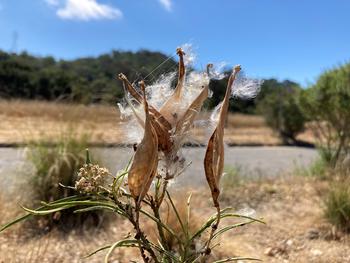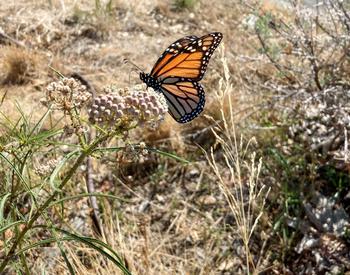Signals of the season
-
Alice Cason
-
As fall approaches, signals tell the monarch butterflies (Danaus plexippus) to start their journey toward their overwintering sites. They may sense the Earth’s magnetic fields, internal sun compass, and other signals to navigate back to the same sites their ancestors inhabited the year before. The long-distance migration, achieved by several breeding generations, serves as a behavioral defense against parasitic transmission and cold weather.
 Signaling the beginning of fall, seed pods break open on Asclepias fascicularis. The seeds are connected to a white floss to help them spread in wind.
Signaling the beginning of fall, seed pods break open on Asclepias fascicularis. The seeds are connected to a white floss to help them spread in wind.In Western North America, monarchs migrate between the Rocky Mountains to almost 400 overwintering sites along the California Coast and Mexico. A suitable location has a microclimate with low light and little wind. It has a canopy of trees and access to water or the drip of fog. There monarchs stay in a state of diapause (not mating or laying eggs), conserving fat for survival and spring dispersal. They form clusters (roosts) with other butterflies and huddle to keep warm and protected from weather conditions and predators. They continue to seek water and nectar from flowers around their roosts.
Marin County is fortunate to host both breeding and overwintering populations of Western Monarchs. In the fall, we may see breeding populations on the way to the coast. They will be here looking for nectar and host plants, specifically the Asclepias fascicularis and Asclepias speciosa. We may observe the complete metamorphosis. They hatch from an egg to a caterpillar (larva), then become a chrysalis and finally a mature adult butterfly. These stages may take a few weeks and launch a new generation of monarchs. Protect breeding and migratory habitat with the cultivation of narrow leaf milkweed, Asclepias fascicularis, in the inland areas.
Protect breeding and migratory habitat with the cultivation of narrow leaf milkweed, Asclepias fascicularis, in the inland areas.Dormancy is your garden’s way to thrive in fall and winter conditions. Here are things you can do this fall in your butterfly garden when the plants take advantage of a period of rest:
- Respect the overwintering sites and habitats. Do not plant milkweed host plants (Asclepias fascicularis and Asclepias speciosa) within 5 miles of the coast. Stinson Beach, Bolinas, Muir Beach, and Fort Baker have overwintering sites on public and private lands. There the milkweed host plants can interfere with signals for migration.
- Do plant fall blooming native nectar plants to attract insects, birds, and other wildlife that depend on them for survival. For example, add the fall blooming blue California Asters (Symphytorichum chilense), west coast goldenrod (Solidago elongata), deep pink Coyote mint (Monardela villosa), and bright red California fuchsia (Epilobium canum). For a complete list of fall blooming plants, see https://marinmg.ucanr.edu/CARE/MONTHLY_CARE/October/.
- Remember that milkweeds go dormant. The leaves will die back, turn yellow and drop. This is part of the life of a milkweed plant. We do not want monarchs to get confused and keep breeding on warm days when there are no host plants for the caterpillars to eat. Don’t worry; they will pop up again in the spring to welcome the monarchs back to Marin.
- Avoid the use of pesticides. Seek non-chemical solutions to prevent and manage pests in your garden and landscaping. Check the MMG website for the IPM methods: https://marinmg.ucanr.edu/PROBLEMS/PESTICIDES_CHEMICALS/.
- Help enhance biodiversity by saving seeds. Milkweed seeds are wind pollinated. They form pods that break open and release their seeds connected to white floss that flies in the wind. Make or buy a small net bag, one that allows light to enter and cover and capture the seeds before they disperse. For additional instructions on how to collect, store and save seeds: https://marinmg.ucanr.edu/CARE/PROPAGATING/SeedSaving/
Protect Monarch butterflies by not planting tropical milkweed. Asclepias Curassavica is not native to California and does not die back in the winter. As a result, the parasite Ophryocystis elektroscirrha (OE) can persist on the leaves. As monarch larvae ingest the spores, they become infected, which can cause death. In addition, tropical milkweed can confuse monarchs into breeding when they should be overwintering. This plant has recently been prohibited from sale in Marin County as a B- rated weed by the Marin County Agriculture Commission.
Photos: Alice Cason


